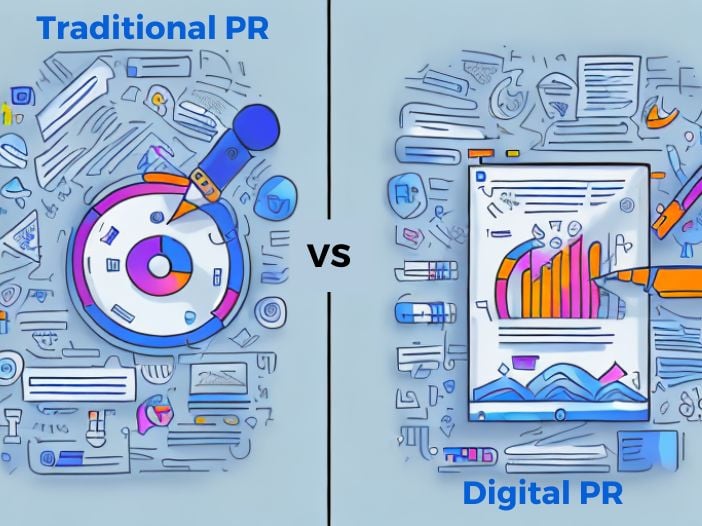Public relations (PR) is an essential aspect of any business or organization that aims to build a positive image, establish trust, and gain credibility among the public.
However, with the advent of modern technology, traditional PR approaches may not cut it anymore.
Digital PR has emerged as a new and effective way to establish and maintain a brand’s reputation.
In this article, we will discuss the advantages and disadvantages of digital PR over traditional PR.
Understanding Digital PR and Traditional PR
Public relations (PR) has become essential to any organization’s communication strategy in today’s fast-paced and ever-evolving digital landscape.
PR is all about creating and maintaining a positive image of the organization and its brand in the eyes of the public.
However, with the rise of digital media and the increasing use of online tools and platforms, the traditional approach to PR has undergone a significant transformation.
This has given rise to two distinct branches of PR – Digital PR and Traditional PR.
Defining Digital PR
Digital PR refers to using online tools, platforms, and channels to create, maintain, and manage a brand’s reputation.
The primary goal of digital PR is to communicate and engage with the target audience, create brand awareness, and promote the organization’s values, goals, and objectives.
Digital PR is a dynamic and evolving field that requires constant monitoring and adaptation to keep up with the fast-paced digital landscape.
One of the key advantages of digital PR is its ability to reach a wider audience.
With the increasing use of social media, blogs, and other online platforms, digital PR has become an effective way to engage with customers and build brand loyalty.
Digital PR provides real-time feedback, allowing organizations to respond quickly to customer queries and concerns.
Another advantage of digital PR is its cost-effectiveness. Compared to traditional PR, digital PR is relatively inexpensive, making it an attractive option for small businesses and startups.
Digital PR also allows organizations to track and measure the effectiveness of their PR campaigns, providing valuable insights into customer behavior and preferences.
Defining Traditional PR
Traditional PR is a more conventional approach to public relations, relying on traditional media channels such as newspapers, TV, radio, and print advertisements to communicate with the public.
Traditional PR focuses on building relationships with journalists, editors, and other media personnel to secure positive editorial coverage and media exposure.
Traditional PR emphasizes long-term relationships with key stakeholders, community engagement, and community involvement.
One of the key advantages of traditional PR is its ability to provide credibility and legitimacy to the organization.
Positive coverage in traditional media channels can help build trust and establish the organization as a reputable and reliable source of information.
Traditional PR also allows organizations to reach a wider audience, including those who may not be active on digital platforms.
However, traditional PR can be expensive and time-consuming, requiring significant resources to secure media coverage.
It also provides limited opportunities for real-time feedback and engagement with customers.
Both digital PR and traditional PR have their advantages and disadvantages, and organizations must carefully consider their communication strategy to determine which approach is best suited to their needs.
While digital PR offers a cost-effective and efficient way to engage with customers and build brand loyalty, traditional PR provides credibility and legitimacy to the organization.
Ultimately, the key to a successful PR strategy is to find the right balance between digital and traditional approaches, leveraging the strengths of each to create a comprehensive and effective communication plan.
Advantages of Digital PR
Digital PR is a powerful tool for businesses to reach their target audience and improve their online presence.
We will explore the various advantages of digital PR and how it can benefit your organization.
Cost-Effectiveness
One of the significant advantages of digital PR is its cost-effectiveness. Compared to traditional PR methods, digital PR allows businesses to reach a broad audience at a minimal cost.
With the rise of digital channels and social media, businesses can target their audience more precisely, reducing marketing costs and improving ROI.
Businesses can save money by leveraging digital PR while still achieving their marketing objectives.
Wider Reach and Targeting
Digital PR offers a wider reach to the target audience. With the internet and social media, brands can reach a global audience, breaking geographical boundaries.
Additionally, digital PR offers precise targeting, allowing businesses to tailor their message to specific demographics, interests, and behaviors, resulting in improved engagement and conversions.
Businesses can achieve a higher ROI and improve their marketing efforts’ effectiveness by targeting the right audience.
Real-Time Analytics and Reporting
Digital PR provides real-time analytics and reporting, allowing businesses to accurately track and measure their PR campaigns’ effectiveness.
Brands can employ metrics such as impressions, click-through rates, engagement rates, and conversions, providing actionable insights into their PR campaigns.
By analyzing these metrics, businesses can optimize their PR campaigns to achieve better results and improve their marketing efforts’ effectiveness.
Flexibility and Adaptability
Digital PR offers flexibility and adaptability, enabling businesses to respond to current events and public sentiment in a timely fashion.
With the internet and social media, brands can communicate directly with their audience, address concerns, and resolve issues quickly, boosting their reputation as a customer-friendly and responsive organization.
By being flexible and adaptable, businesses can stay ahead of the competition and maintain a positive image in the eyes of their target audience.
Improved SEO and Online Presence
Digital PR improves your website’s SEO by providing valuable backlinks and signals to boost search engine rankings.
By optimizing content and using keywords, businesses can enhance their visibility on search engines and improve their credibility in their niche.
By improving their online presence, businesses can attract more traffic to their website, generate leads, and improve their overall marketing efforts’ effectiveness.
Digital PR is a powerful tool for businesses to reach their target audience, improve their digital presence, and achieve their marketing objectives.
By leveraging the various advantages of digital PR, businesses can save money, improve their marketing efforts’ effectiveness, and stay ahead of the competition.
Disadvantages of Digital PR
Digital PR, while an effective tool for businesses to reach their target audience, also comes with challenges that can hinder a brand’s success.
Let’s take a closer look at some of the most significant disadvantages of digital PR.
Overwhelming Amount of Information
One of the biggest challenges of digital PR is the overwhelming amount of information available online.
With so much content being produced and shared daily, it can be challenging for brands to cut through the noise and deliver their message effectively to their target audience.
Brands must find creative ways to stand out and grab their audience’s attention in a sea of competing messages.
Moreover, digital media channels are flooded with competing messages, making grabbing the audience’s attention more challenging.
Brands need to be strategic in their approach to digital PR and find ways to differentiate themselves from their competitors.
Shorter Attention Spans
In the digital age, people’s attention spans have decreased, making it more challenging for businesses to communicate their messages effectively within a short period.
Digital PR requires a concise and straightforward message that quickly captures the audience’s attention.
This requirement can make creating a brand identity and loyalty more challenging than traditional PR.
Brands must find creative ways to engage their audience and keep them interested in their message.
This can be achieved through compelling visuals, interactive content, and personalized messaging.
Potential for Negative Publicity
Digital PR increases the chances of negative publicity due to public feedback and online reviews.
Brands must monitor and respond to feedback effectively to avoid negative publicity that could significantly damage the brand’s reputation.
Brands must proactively manage their online presence and public image in the digital age.
Brands need a crisis management plan to address any negative publicity quickly and effectively.
This can include monitoring social media channels, responding to negative feedback promptly, and addressing any issues that arise transparently and honestly.
Reliance on Technology and Internet Access
Digital PR depends entirely on technology and internet access, limiting the audience’s reach who do not have access to modern technology.
Additionally, technical glitches and downtime can disrupt advertising campaigns, wasting marketing resources.
Brands need to be aware of the limitations of digital PR and find ways to reach their target audience through alternative means.
This can include traditional PR methods such as print advertising, direct mail, and events.
While digital PR offers many advantages for businesses, knowing the potential challenges and limitations is essential.
By understanding these disadvantages and finding creative ways to overcome them, brands can effectively leverage digital PR to reach their target audience and achieve their marketing goals.
Advantages of Traditional PR
Building Long-Term Relationships
Traditional PR emphasizes long-term relationships with stakeholders, including journalists, editors, and community members.
Building trust and goodwill with these stakeholders can help businesses secure favorable media coverage, establish brand identity and increase loyalty.
Credibility and Trustworthiness
Traditional PR lends credibility and trustworthiness to a brand’s message.
Editorial coverage and endorsements carry more weight with the public compared to paid advertisements, enhancing the brand’s reputation and gaining the public’s trust.
Tangible and Lasting Impressions
Traditional PR creates tangible and lasting impressions with the audience.
Newspaper clippings, physical advertisements, and radio spots have a tangible and lasting impact, allowing the audience to recall the brand’s message over an extended period.
Access to Non-Digital Audiences
Not all audiences are digital, and traditional PR offers access to non-digital audiences.
For instance, print advertisements can reach older demographics who prefer physical newspapers.
Additionally, traditional PR can create a buzz that translates into digital exposure, increasing the brand’s reach.
Disadvantages of Traditional PR
Traditional PR can be more expensive and less focused than digital PR.
With the rise of digital media, traditional PR has lost some relevance and effectiveness, limiting the audience’s reach and fostering a longer turnaround time for campaign insights.
Traditional PR also lacks some of the real-time analytics and reporting options that digital PR provides.
Conclusion
Businesses need to consider using a mix of digital and traditional PR approaches to create and maintain their brand’s reputation.
Digital PR offers a cost-effective, precise, and real-time approach to reaching a wider audience, tracking and measuring campaigns, and engaging with the online public.
However, digital PR has challenges, such as managing negative publicity and overwhelming information.
Traditional PR may have advantages, such as creating tangible and long-lasting impressions and reaching non-digital audiences, but digital media channels are more focused and effective.
By weighing the pros and cons of each approach, an organization can leverage the benefits of both traditional and digital PR to create a comprehensive and robust public relations strategy.





